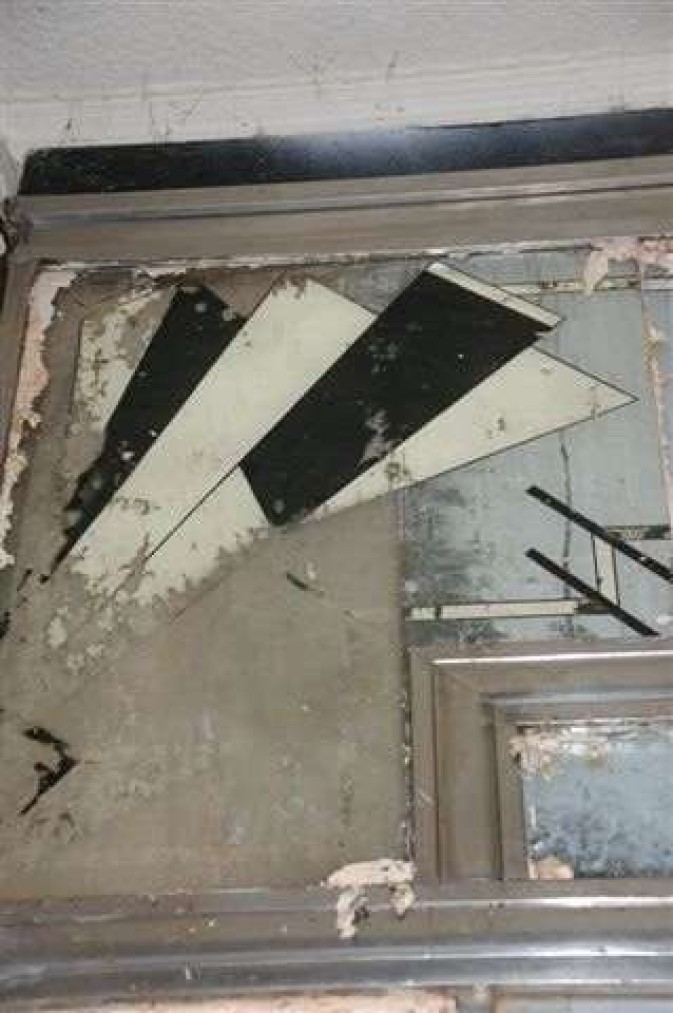Another of the original art deco designs features framing the sign above the Roxy Cafe
This is on the original sign from 1936.
Restored signage, 2011
From WIKI The structure of Art Deco is based on mathematical geometric shapes. It was widely considered to be an eclectic form of elegant and stylish modernism, being influenced by a variety of sources. The ability to travel and archaeological excavations during the first decades of the twentieth century, influenced artists and designers, integrating several elements from countries not their own. Among them were historical styles such as Greco-Roman Classicism, as well as the art of Babylon, Assyria, Ancient Egypt, Aztec Mexico, and Africa.
Much of this could be attributed to the popular interest in archaeology during the 1920s (e.g., the tomb of Tutankhamun, Pompeii, Troy, etc.). Art Deco also used Machine Age and streamline technologies such as modern aviation, electric lighting, radio, ocean liners and skyscrapers for inspiration. Streamline Moderne was the final interwar-period development, which most thoroughly manifests technology and has been rated by some commentators as a separate architectural style.
Art-deco design influences were expressed in the crystalline and faceted forms of decorative Cubism and Futurism. Other popular themes of Art Deco were trapezoidal, zigzagged, geometric, and jumbled shapes, which can be seen in many early works.
The Peters and Co, Roxy Cafe, Bingara sign, features exquisitely designed geometric art work in the Art Deco style
Bingara Advovate, 23rd April, 2011
Funding secured to restore the Roxy Cafe’s etched signage on windows
Download a .pdf version of this article, here:
Bingara_Adv_March_23_04c.pdf
The Gwydir Shire Council has been successful in securing a significant grant to undertake the conservation of the etched glass that adorns the facade of The Roxy Café.
The grant has been provided by the Heritage Branch of the Department
of Planning of NSW. The Council will be the recipient of $30,000 to complete the work.
The etched glass is an important component of the story of The Roxy Café. It demonstrates how the cafe advertised in the 1930s through the colours, patterns and lettering on the glass which are excellent examples of Art Deco design.
“The restoration of The Roxy Café and the etched glass provides a unique example of the creative integration of a dynamic contemporary usage within a building of significant heritage value,” said Sandy McNaughton, Manager of The Roxy.
There are very few companies left in Australia that carry out this type of specialised restoration work. Michael Harrington is the Managing Director of Harradence Glass
Decorators based in Sydney. When contacted about The Roxy, Mr Harrington stated that in his twenty-five years experience with this type of glass work, “The Roxy Café comprises one of the most significant examples of its kind that I have seen.”
“There are very few examples of this type of etched glass left in Australia” Mr Harrington said. “Reproduction of this work will require craftsmanship at a level that is very rare in what has become a digital age.” “Our company has all of the required skills to restore much of the
degraded glass work to its former glory. We will be utilizing all of the original techniques that were in use in 1936.”
“Work undertaken in the restoration will include incorporating the screen printing of the original graphic with line work, etching, sand blasting, mirroring and silver gilding the masking, colourbacking and acid etching required.” Mr Harrington said. “Personally, I am excited about a project incorporating such beautiful art deco style.”
Sandy McNaughton adds that “From the moment the original Funding secured to restore the
Roxy Cafe’s etched windows Doug Dunlop of Domenico Blu Building revealing the etched glass in May 2010
The etched glass window is a rare example and its restoration is of great importance to the Roxy Cafe etched glass was uncovered during the restoration of the Café, it was apparent that funding should be sought to restore this unique feature.” “Since contacting Mr Harrington, it is evident that we have underestimated the significance of the etched glass. I have been informed that it is an incredibly rare example” said Sandy. “We are thrilled to have received this funding from the NSW Heritage Branch.”
“The Roxy serves to remind us that we are part of a cultural continuum. It is through its ability to provide an historic cultural experience in a contemporary context that it reinforces our appreciation of, and responsibility to, preserve and protect our past, as well as to recognise the changing cultural landscape it represents.”
It is timely that the grant text changed from this point was received just before the planned celebration for the 75th Anniversary of The Roxy which were be held on the weekend of April 9 and 10.
“The official launch of the Café and the Greek Gala Ball is generated huge excitement within the Kytherian and wider Greek community. Everyone enjoyed a truly memorable weekend,” said Sandy
The Gala Ball was organised by the Gwydir Shire Council.
Roxy Website Main Page
Roxy Theatre, Main Page
Roxy Café, Main Page
Roxy Museum, Main Page
Katsehamos and the Great Idea, the Book
Restoration of Kytherian and Hellenic Sacred sites
Buffer Map of the distances from Bingara to major cities of Kytherian and Hellenic population
